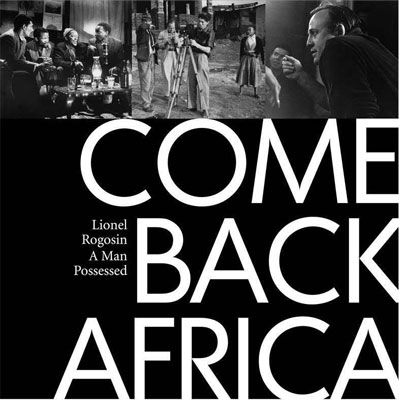Book information
ISBN: 978-1-919855-17-2
Trim size: 240 x 240mm
Binding: hardcover
Page count: 142 pages
Imagery: tbc
Cost: R425.00
Genre: Film / Cultural History
Description
Having already produced the widely acclaimed film, On the Bowery, about New York City’s skid row, Lionel Rogosin came to South Africa in the late 1950s to explore the idea of making a film that would ‘give a voice to the oppressed’. He quickly made contact with Can Themba, Bloke Modisane and Lewis Nkosi; writers associated with the crusading magazine, Drum, who have become legends in their own right. It was Rogosin’s willingness to place Blacks at the centre of the film-making process and let them speak for themselves about life under apartheid that made this film entirely unique. Fortunately, Lionel Rogosin wrote down the story of what he and his Come Back Africa colleagues went through to make this important film. Peter Davis, a filmmaker who knew Rogosin well, has edited this into a highly readable account of what was, in effect, a grueling and often dangerous encounter with apartheid society.
Come Back Africa reads like a suspense story as we are caught up in Rogosin’s obsession. It takes us on a journey back in time to when the foundations of the apartheid state were being laid and give us a wonderful sense of what life was like in 1950s Johannesburg — especially the much mythologised Sophiatown.
Rogosin’s insights and comments, as he tries to unravel and come to grips with the perplexing mess of racial intolerance, domination and bigotry that was South Africa, are revealing — about the times but also about Rogosin’s own views and prejudices.
This book is a wonderful addition to the few treasured resources available to us about that period.
ABOUT THE AUTHOR

Lionel Rogosin
Lionel Rogosin (22 January 1924, New York, New York – 8 December 2000, Los Angeles, California) was an independent American filmmaker who worked in political cinema, non-fiction partisan filmmaking and docu-fiction, influenced by Italian neorealism and Robert Flaherty.
Born and raised on the East Coast of the United States, Lionel Rogosin attended Yale University and obtained a degree in chemical engineering in order to join his father’s business. He served in the United States Navy during World War II. Upon his return, he spent his free time traveling in war-ridden Eastern Europe and Western Europe and Israel as well as a trip to Africa in 1948. He then worked in his father’s company until 1954, while teaching himself film with a 16mm Bolex camera. Concerned with political issues including racism and fascism, Rogosin participated in a United Nations film titled Out, a documentary about the plight of Hungarian refugees.
At this juncture, Rogosin devoted himself to promoting peace and confronting issues such as nuclear war, imperialism, and racism. Apartheid was his first target, but in order to make a film against it, he decided to learn by filming the Bowery, New York’s skid row, an effort influenced by the documentaries of Robert J. Flaherty. Thus he made On the Bowery in 1955–1956 in the tradition of neo-realism. The film was the first American film to receive the Grand Prize for Documentary at the Venice Film Festival in 1956. It also received a British Academy Film Award in 1956 and was nominated for an Academy Award.
On the Bowery received critical acclaim and made a great impression in Eastern Europe and England. The newly formed Free Cinema in London, founded by Lindsay Anderson, Lorenza Mazzetti, Karel Reisz, and Tony Richardson, invited Rogosin for its second programme.
Turning to the struggle against apartheid, Rogosin, with a small crew and under the pretense of making a commercial film on African music, clandestinely documented the life of a Black South African migrant worker in Johannesburg. Completed in 1958 with nonprofessional actors and a young and yet-undiscovered African singer named Miriam Makeba, Come Back, Africa won the Critics’ Film Award at the Venice Film Festival. Rogosin arranged for Makeba to leave South Africa by bribing officials. He placed her under contract and arranged her first appearance on American television, on The Steve Allen Show. Rogosin supported Makeba financially, paying for her trip and living expenses when she left South Africa and traveled throughout Europe and the United States.
Aware of the difficulties of distributing independent films in the United States, Rogosin purchased the Bleecker Street Cinema in New York City in 1960. In that same period, he was a founding and active member of the New American Cinema movement and The Film-Makers’ Cooperative, along with Jonas and Adolfas Mekas, Shirley Clarke, Robert Downey Sr and many others, whose films were shown at the Bleecker Street Cinema.
Rogosin sold the Bleecker Street Theater in 1974 and brought Impact Films to an end in 1978. Though he continued to develop many film projects on subjects such as Navajo Indians, police brutality, Paul Gauguin, and a musical about street children in Brazil, he never was able to raise enough money to film them. Despite critical success in Europe and among other American independent filmmakers, he was by and large neither recognised nor supported in the US. He moved to England in the 1980s where he turned to writing. With his health deteriorating, he went back to Los Angeles in the late 1990s.
Lionel Rogosin died in Los Angeles in December 2000. He is interred in the Hollywood Forever Cemetery, Hollywood, California.

